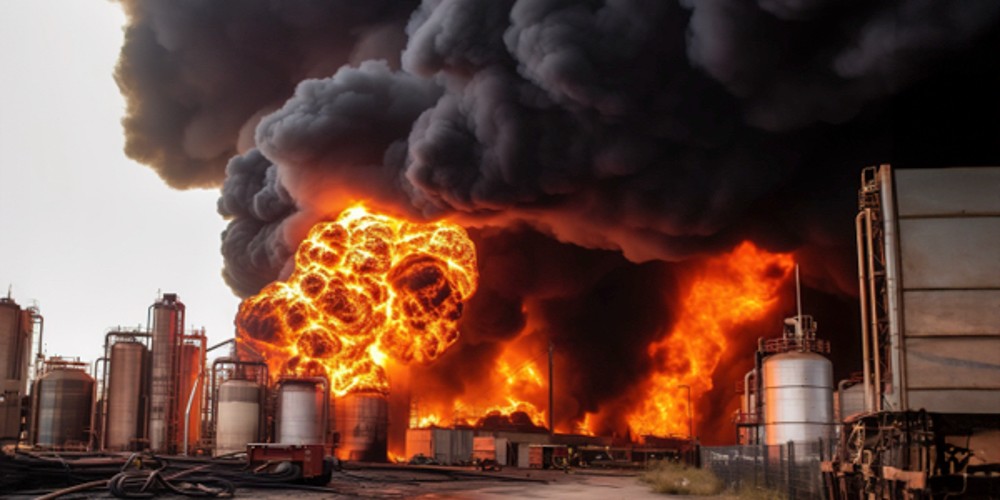(Natural News)—From fake climate-change wildfires that fuel the green new scam agenda, to food and fertilizer processing plants across America serendipitously blowing up and burning down, and from bridges being destroyed by so-called “hacked” cargo ships, to livestock being poisoned with arsenic and spike protein injections, we are all witnessing the planned destruction of the Republic, one key infrastructure entity at a time.
The only way the Democrats can succeed in turning America into a socialist hell-hole, as they wish, is to eliminate the middle-class entirely. This requires ruining the infrastructure of fuel, food, water and other key supplies to the extent that they are either hardly available, unaffordable, or utterly non-existent. Ever since the supply chain got crippled across the board during the COVID plandemic, and inflation driven out the roof by all of this, it’s just been one major mishap after another, and every fire, explosion or demolition is called “accidental” by mainstream news. How convenient that the fake news narrative always fits the political agenda of the Left.
Unexplained explosion at Texas chicken farm a major blow to U.S. food supply
At the end of January, San Antonio news reported two chicken farm buildings at Feather Crest Farms were engulfed in flames after some massive explosions that rocked the chicken plant. Nearly twenty thousand dairy cows were killed, among other animals vital to the food supply. The plant has been in operation since the 1950s. Firefighters and detectives are not able to identify how this happened, to this day. This is just one incident in a long string of food facility explosions and fires that have been occurring since the COVID scamdemic gained momentum.
As the globalists are pushing for all the peons (middle class and poor folks) to eat worms, insects, dirt and Bill Gates’ GMO-lab-made-cancer-causing fake meat, all the meat and egg factories seem to be conveniently going up in smoke (sabotage).
Wait, there’s more. Don’t forget about the food processing plant in Decatur, Illinois exploding, where OSHA claimed to have launched their own “6-month investigation” into the mishap. Then there was the fertilizer plant in Austin, Texas that burned to the ground. Plus, the American Plant Food Corporation in Bartlett, Texas, that “caught fire” somehow and became completely and fully engulfed in flames so bad the fire department there couldn’t handle it themselves. Looks like the U.S. government, once again, is trying to starve out the middle class, as the cost of meat, eggs, dairy, and fresh food skyrockets, while the processing plants keep catching fire and blowing up, like clockwork.
Nobody knows who would have enough money (George Soros) to hire criminals to create these arson events, but they can’t ALL be “accidents” as the infrastructure of the food supply chain falls like dominoes. Like demolition.
Train derailment in East Palestine, Ohio was loaded with toxic vinyl chloride that authorities decided to turn into a burning terrorism event
Oh yes, they did. The U.S. government knows how to turn any small mishap into a national catastrophe, and the derailment of a train carrying some of the world’s most deadly toxin, vinyl chloride, was the epitome of this staged event. Now, staged doesn’t mean fake, because this really happened, but rather that the event was turned into such a major catastrophe, of epic proportions, that it made the national and even world news. Anyone with any common sense and morals would have known NOT to set the train’s toxic cargo on fire, but leave it to the U.S. government and the EPA to ruin the soil, environment and food supply with any given opportunity, especially over the last few years.
Then there was the massively obvious staged event where a loaded cargo ship turned 45 degrees at the last minute in order to conveniently destroy one of the only two necessary support pylons of the Baltimore Bridge. This had ALL the signs of an inside job, and all of fake news narrative was quick to call it an accident (within a couple hours they all had the same fake narrative). This was a major supply thoroughfare for chemicals, weapons, vehicles, food and more that’s now incapacitated for a whole decade. Thanks Biden.
So the question remains: What STAGED infrastructure and supply-line destruction event will be next for the Biden Regime? Tune your apocalypse dial to Preparedness.news for updates on real news about surviving and thriving the staged wildfires, explosions and government-planned demolition of the U.S. supply chain and infrastructure.
Sources for this article include:



